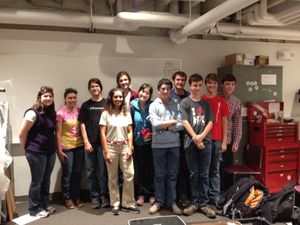This morning I visited a calculus class at BU taught by Professor Brian Lukoff. Brian works with Eric Mazur at Harvard and uses the peer instruction model. He taught his class using Learning Catalytics. Similar to InterLACE, the teacher would ask a question. Each student (instead of groups of students) had their own laptop and would answer the question. The professor could display their answers on the projection screen and discuss their answers. Although I did not stay for it, one of the hallmarks of LC is that it pairs up students with different answers to debate the questions. Sitting at the back of the lecture hall, I was amazed how when using LC the students were focused. But the instant the professor started to lecture/explain how a problem work, the entire class went onto Facebook.
 After school, down at the robotics lab, Anita Sengupta, a NASA engineer and BU Engineering alum (class of ’98) talked to our students about the Mars Curiosity mission. In the above photo you can see Dr. Sengupta with our students. Dr. Sengupta designed the parachute for the mission, which has to slow the lander through supersonic speeds.
After school, down at the robotics lab, Anita Sengupta, a NASA engineer and BU Engineering alum (class of ’98) talked to our students about the Mars Curiosity mission. In the above photo you can see Dr. Sengupta with our students. Dr. Sengupta designed the parachute for the mission, which has to slow the lander through supersonic speeds.
You can learn about the mission here.
Here you can see one of our mentors, Thomas holding a prototype of the parachute.
From the lab, I went to the BUA Donor Leadership dinner, where I learned the art of Sabrage from Eric Vogt. Eric teaches a class in Wine tasting at Harvard and gave us an interesting lesson in Bordeaux tonight. Here we can see Eric explaining Sabrage and a challenge to physics students.

